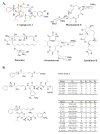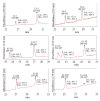Analysis of the cryptophycin P450 epoxidase reveals substrate tolerance and cooperativity
- PMID: 18366166
- PMCID: PMC2697446
- DOI: 10.1021/ja710520q
Analysis of the cryptophycin P450 epoxidase reveals substrate tolerance and cooperativity
Abstract
Cryptophycins are potent anticancer agents isolated from Nostoc sp. ATCC 53789 and Nostoc sp. GSV 224. The most potent natural cryptophycin analogues retain a beta-epoxide at the C2'-C3' position of the molecule. A P450 epoxidase encoded by c rpE recently identified from the cryptophycin gene cluster was shown to install this key functional group into cryptophycin-4 (Cr-4) to produce cryptophycin-2 (Cr-2) in a regio- and stereospecific manner. Here we report a detailed characterization of the CrpE epoxidase using an engineered maltose binding protein (MBP)-CrpE fusion. The substrate tolerance of the CrpE polypeptide was investigated with a series of structurally related cryptophycin analogues generated by chemoenzymatic synthesis. The enzyme specifically installed a beta-epoxide between C2' and C3' of cyclic cryptophycin analogues. The kcat/Km values of the enzyme were determined to provide further insights into the P450 epoxidase catalytic efficiency affected by substrate structural variation. Finally, binding analysis revealed cooperativity of MBP-CrpE toward natural and unnatural desepoxy cryptophycin substrates.
Figures





Similar articles
-
A Versatile Chemoenzymatic Synthesis for the Discovery of Potent Cryptophycin Analogs.ACS Chem Biol. 2020 Feb 21;15(2):524-532. doi: 10.1021/acschembio.9b00998. Epub 2020 Feb 3. ACS Chem Biol. 2020. PMID: 31961651 Free PMC article.
-
Biosynthetic characterization and chemoenzymatic assembly of the cryptophycins. Potent anticancer agents from cyanobionts.ACS Chem Biol. 2006 Dec 15;1(12):766-79. doi: 10.1021/cb6004307. ACS Chem Biol. 2006. PMID: 17240975
-
Isolation and structure determination of cryptophycins 38, 326, and 327 from the terrestrial cyanobacterium Nostoc sp. GSV 224.J Nat Prod. 2004 Aug;67(8):1403-6. doi: 10.1021/np0499665. J Nat Prod. 2004. PMID: 15332864
-
Cryptophycins: a novel class of potent antimitotic antitumor depsipeptides.Curr Pharm Des. 2001 Sep;7(13):1259-76. doi: 10.2174/1381612013397474. Curr Pharm Des. 2001. PMID: 11472266 Review.
-
Recent approaches for the synthesis of modified cryptophycins.Nat Prod Rep. 2013 Jul;30(7):924-40. doi: 10.1039/c3np70022d. Nat Prod Rep. 2013. PMID: 23732943 Review.
Cited by
-
Cooperative properties of cytochromes P450.Pharmacol Ther. 2009 Nov;124(2):151-67. doi: 10.1016/j.pharmthera.2009.05.011. Epub 2009 Jun 23. Pharmacol Ther. 2009. PMID: 19555717 Free PMC article. Review.
-
Mechanism-Guided Design and Discovery of Efficient Cytochrome P450-Derived C-H Amination Biocatalysts.J Am Chem Soc. 2020 Jun 10;142(23):10343-10357. doi: 10.1021/jacs.9b12859. Epub 2020 Jun 1. J Am Chem Soc. 2020. PMID: 32407077 Free PMC article.
-
Cytochrome P450s in algae: Bioactive natural product biosynthesis and light-driven bioproduction.Acta Pharm Sin B. 2022 Jun;12(6):2832-2844. doi: 10.1016/j.apsb.2022.01.013. Epub 2022 Jan 24. Acta Pharm Sin B. 2022. PMID: 35755277 Free PMC article. Review.
-
Efficient, divergent synthesis of cryptophycin unit A analogues.Chem Commun (Camb). 2012 May 22:10.1039/c2cc32417b. doi: 10.1039/c2cc32417b. Online ahead of print. Chem Commun (Camb). 2012. PMID: 22617820 Free PMC article.
-
A Versatile Chemoenzymatic Synthesis for the Discovery of Potent Cryptophycin Analogs.ACS Chem Biol. 2020 Feb 21;15(2):524-532. doi: 10.1021/acschembio.9b00998. Epub 2020 Feb 3. ACS Chem Biol. 2020. PMID: 31961651 Free PMC article.
References
-
- Welker M, von Dohren H. FEMS Microbiol Rev. 2006;30:530–563. - PubMed
-
- Clardy J, Fischbach MA, Walsh CT. Nat Biotechnol. 2006;24:1541–1550. - PubMed
-
- Golakoti T, Yoshida WY, Chaganty S, Moore RE. J Nat Prod. 2001;64:54–59. - PubMed
-
- Schwartz RE, Hirsch CF, Sesin DF, Flor JE, Chartrain M, Fromtling RE, Harris GH, Salvatore MJ, Liesch JM, Yudin K. J Indust Microbiol. 1990;5:113–123.
Publication types
MeSH terms
Substances
Grants and funding
LinkOut - more resources
Full Text Sources
Other Literature Sources
Miscellaneous

